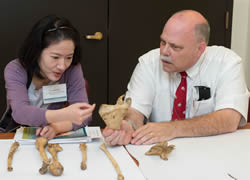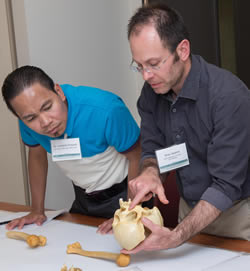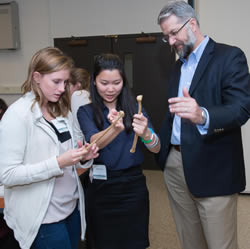Museum offers course in forensic anthropology
By Paul Bello, National Museum of Health and Medicine
SILVER SPRING, Md. - A forensic anthropology course directed by the National Museum of Health and Medicine (NMHM) recently brought together fellows in forensic pathology, forensic educators, military personnel and state and city employees from around the country to provide an overview of the value provided by forensic anthropologists to medical/legal death investigations. Subjects included detection and recovery of human remains, human identification, developing a biological profile and an emphasis on anthropological trauma analysis to aid the pathologist in determining the cause and manner of death.
Brian Spatola, NMHM anatomical collections manager, was course director along with Franklin Damann, NMHM anatomical curator. The course began nearly three decades ago and was held this year at the Uniformed Services University (USU) on the campus of the Walter Reed National Military Medical Center (WRNMMC).
"A major focus of this course is to demonstrate that anthropology has much more value than what many of those attending have been exposed to," Spatola said. "In addition, participants will see specimens of common conditions, but they will also see things they will not see again. This course shows the value of our museum collection and how it can be used in an educational setting."
Course workshops focused on the perspective of forensic pathologists and were of particular interest to those in the fellowship phase of their training, as that group is always the largest represented each year, according to Spatola.
Course faculty this year was comprised of professionals from such agencies as the Federal Bureau of Investigation, National Transportation Safety Board, Office of the Armed Forces Medical Examiner, Smithsonian National Museum of Natural History and the Office of the Chief Medical Examiner for the District of Columbia. The course also relies on support from the Henry M. Jackson Foundation for the Advancement of Military Medicine, which handled the registration process on behalf of NMHM.
"We teach the participants that forensic anthropologists are often capable of serving additional key functions depending on their background and training," Spatola said. "They can manage the identification process, establish disaster victim identification (DVI) procedures and provide trauma analysis in support of the medical examiner. Anthropologists have adapted to broader roles in a medical examiner's office that some pathologists may not be aware of."
Information on NMHM education programs can be found at www.medicalmuseum.mil.

|
Caption:
Dr. Julia Chu, pathologist with the Los Angeles Coroner's Office (left) and Dr. David Hunt, anthropologist with the
Smithsonian Museum of Natural History, participate in the National Museum of Health and Medicine 28th annual forensic
anthropology course, held from June 22-25, 2015 in Bethesda, Maryland. (Disclosure: This image has been cropped to emphasize the subject.) (National Museum of Health and Medicine photo by Matthew Breitbart / Released) |

|
Caption:
Dr. Leonardo Roquiro, pathologist (left) and Brian Spatola, anatomical collections manager with the National Museum of
Health and Medicine, collaborate during NMHM's 28th annual forensic anthropology course, held from June 22-25, 2015 in
Bethesda, Maryland. (Disclosure: This image has been cropped to emphasize the subject.) (National Museum of Health and Medicine photo by Matthew Breitbart / Released) |

|
Caption:
Anthropology students Audrey Schaefer and Nandar Yukyi (left to right) are seen with Dr. Franklin Damann, anatomical curator
with the National Museum of Health and Medicine (NMHM), during the museum's 28th annual forensic anthropology course, held
from June 22-25, 2015 in Bethesda, Maryland. (Disclosure: This image has been cropped to emphasize the subject.) (National Museum of Health and Medicine photo by Matthew Breitbart / Released) |



